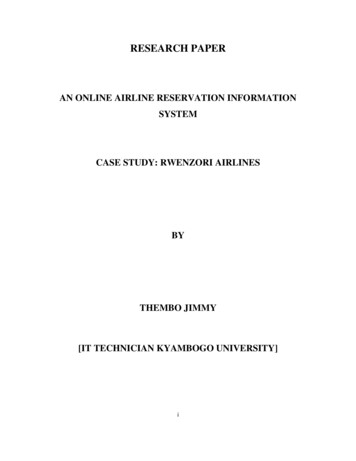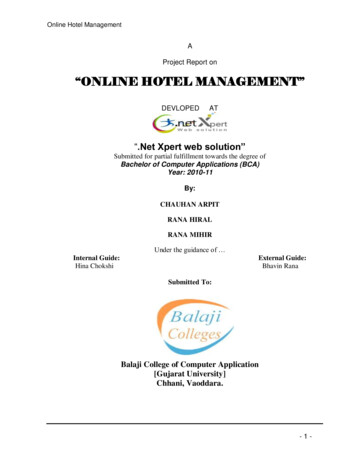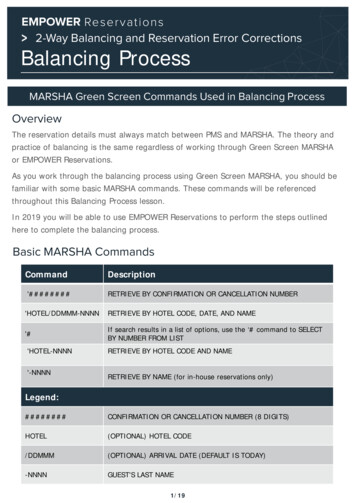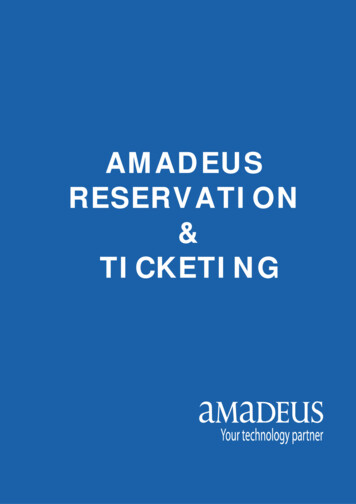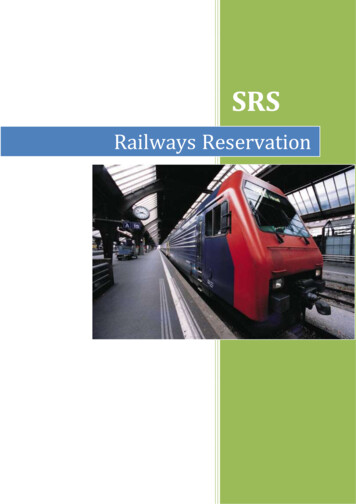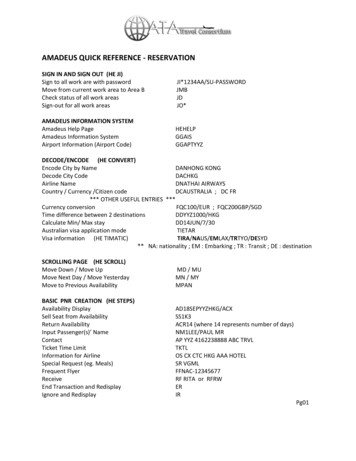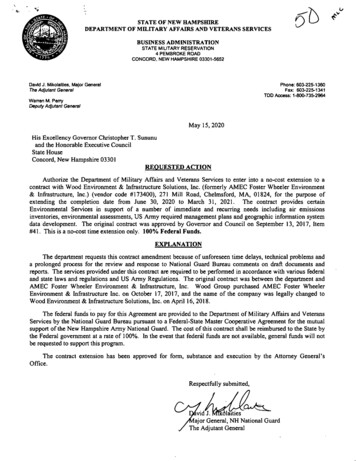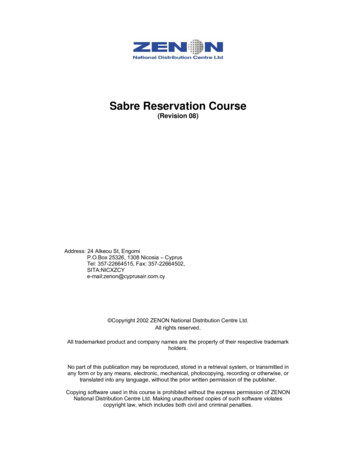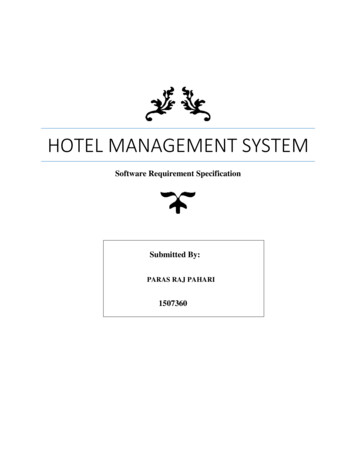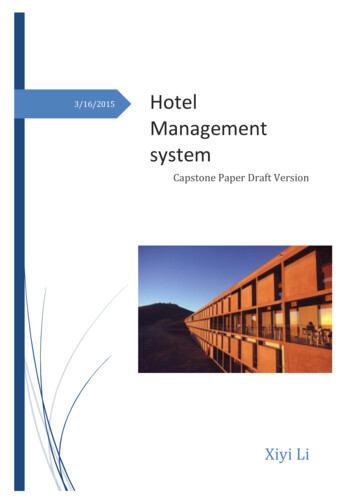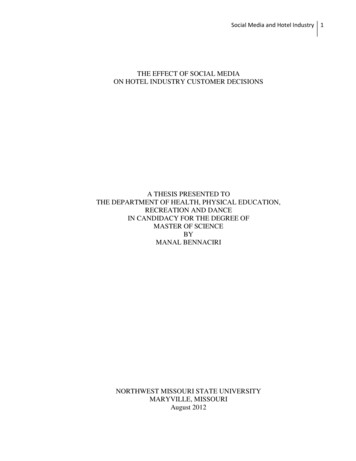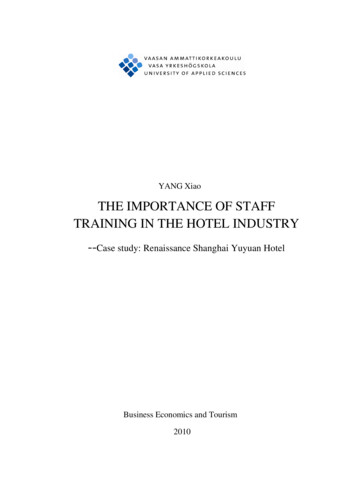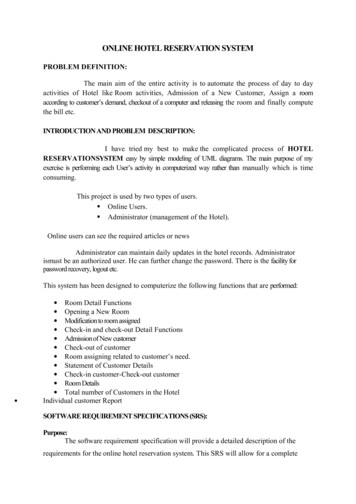
Transcription
ONLINE HOTEL RESERVATION SYSTEMPROBLEM DEFINITION:The main aim of the entire activity is to automate the process of day to dayactivities of Hotel like Room activities, Admission of a New Customer, Assign a roomaccording to customer’s demand, checkout of a computer and releasing the room and finally computethe bill etc.INTRODUCTION AND PROBLEM DESCRIPTION:I have tried my best to make the complicated process of HOTELRESERVATIONSYSTEM easy by simple modeling of UML diagrams. The main purpose of myexercise is performing each User’s activity in computerized way rather than manually which is timeconsuming.This project is used by two types of users. Online Users. Administrator (management of the Hotel).Online users can see the required articles or newsAdministrator can maintain daily updates in the hotel records. Administratorismust be an authorized user. He can further change the password. There is the facility forpassword recovery, logout etc.This system has been designed to computerize the following functions that are performed: Room Detail Functions Opening a New Room Modification to room assigned Check-in and check-out Detail Functions Admission of New customer Check-out of customer Room assigning related to customer’s need. Statement of Customer Details Check-in customer-Check-out customer Room Details Total number of Customers in the HotelIndividual customer ReportSOFTWARE REQUIREMENT SPECIFICATIONS (SRS):Purpose:The software requirement specification will provide a detailed description of therequirements for the online hotel reservation system. This SRS will allow for a complete
understanding of the system and the clear understanding of the system functionality willallow for the correct software to be developed for the end user. From this SRS, the systemcan be designed, constructed, and finally tested.OVERVIEW:The SRS is organized into two main sections. Overall Description. Specific Requirements.The Overall DescriptionThis section describes the general factors that affect the product and its requirements.PRODUCT PERSPECTIVEThis online hotel reservation system is the stand-alone system. It Is totally self contained.Hardware InterfacesThis system will be placed on PC’s throughout the hotel.Software InterfacesIn this system, we maintain two data bases. These databases include hotel rooms andcustomer’s information. These can be modified by the end users. The room databases willinclude the room numbers and if they are vacant or occupied. The customers’ informationdatabase maintains all the information about the customer such as name, number ofoccupants, assigned room, default room rate, phone number, whether or not the room isguaranteed, credit card number etc.Product FunctionsReservation and Booking system Allows for typing in customer informationHas a default room rate that is adjustableIncludes a description field for the changed rateWhen a customer checks in, the room number will be changed to occupied in thedatabaseAbility to modify a reservationwhen a customer checks out the amount owed is displayedrecords that room is vacantrecords paymentallows for space to write customer’s feedback General Manager Servicesand Automated Tasks SystemReports generated to audit hotel occupancy, future occupancy and room revenue.Exception reports listing to the normal costAllows addition, deletion and modification of information on rooms and rates.
Creation of users and assigning passwords.User CharacteristicsEducational level of hotel reservation system computer software-low Experience ofthis software-none Technical Expertise-littleApportioning of RequirementsThe audio and visual alerts will be deferred because of low importance at this time.Assumptions and Dependencieso The system is not required to save the generated reports.o Credit card payments are not included.SPECIFIC REQUIREMENTThis section contains all the software requirements at a level of details ,that whencombine with the system context diagram, use cases, and usecase descriptions, is sufficientenables designers to design a system to satisfy those requirementsExternal InterfacesThis system will use the standard input/output devices for a personal computer. This includesthe following: Keyboard Mouse Monitor PrinterUser InterfacesThe user interface screens are: Login - log into the system as a CSR or Manager. Reservation – Retrieve button, update/save reservation, cancel reservation, changereservation, adjust room rate, accept payment type/credit card. Check-in – Modify room stay (e.g., new credit card), check-in customer (with orwithout a reservation), adjust room rate, special requests, accept payment type/creditcard. Checkout – checkout customer and generate bill. Hotel Payment – accept payment for room. Room service - Create order, modify order, view order, cancel order, generate mealbill. Customer Record – Add or update customer records. Administer rooms – availability and rates. Administer user – create, modify, and delete users; change password. Reports – select, view, save, and delete reports.
Software InterfacesThe system shall interface with an oracle or access database.Hardware InterfacesThe system shall run on Microsoft Windows based system.Communication InterfaceThe system shall be standalone product that does not require anycommunication interfaces.FUNCTIONAL REQUIREMENTSFunctional requirements define the fundamental actions that system must perform.Two categories in Functional Requirements:1. Reservation/booking.2. Management.Reservation/Booking The system shall record reservations. The system shall record customer details. The system shall record the room number. The system shall display the default room rate. The system shall display whether or not the room is guaranteed. The system will generate unique confirmation for each reservation. The system will record expected check in time and date and also expected check outtime and date. The system shall display the amount owed by the customer and record the payment. The system shall record the customer feedback.Management The system shall display the hotel occupancy for a specified period of time. The system shall display the room revenue for a period of time. The system shall display an exception report where default room has been overridden. The system shall allow for the addition, deletion and also modification of information,regarding rooms, rates, and user profiles. The system shall allow managers to assign user passwords.Non-functional RequirementsThis section defines the needs in terms of performance, logical database requirements,design constraints, reliability, availability, security, maintainability, and portability.CHANGE MANAGEMENT PROCESSChanges to this document may be made after approval from the project manager andthe client approval officer
USE CASE DIAGRAMA Use Case specifies the behavior of a system or a part of a system and is adescription of a set of sequences of actions. Use Case Diagram :Use case diagram shows therelationship among use cases within a system or semantic entity and their actors. Therelationships area associations between the actors and the use cases, generalization betweenthe actors.Actors in Online Hotel Reservation System: Client. Travel Agent. Hotel Receptionist. Hotel Administrator .Use cases with brief description:Inquire Information:The customer needs to interact with the hotel interface through the personal system.It involves set of actions.Reserve/Update Reservation:To reserve the room, the customer needs to interact with the website. If thecustomer already reserved room, want some updates regarding the increase in occupancy, hemust able to update the data by using his login and password which can be provided bythe administrator.Pay for Hotel:This involves set of actions. If the customer ready to book or reserve the room, heneeds to enter his complete details and occupancy level. After furnish the details in theform, he demanded to pay the advance. That can be through credit card/debit card. He mustenter the correct card number.Cancel Reservation:The system software should support all the requests made by the each authorizedcustomer. If the customer not satisfied with the facilities and occupancy of each room afterfew hours he checked in, he may want to cancel the reservation for remaining hours. Systemsoftware must be in a position that the payment for the staying hours should captured andcancel the reservation.Update Hotel Information:According to the customer feedback, the administrator is update the hotelinformation such as offers, discounts on rooms and meals provided by the hotel. When thecustomers’ checkout from the hotel, the database need to Update and show the availability tothe new customers.Return Payment:This use case extends cancel reservation. Whenever the customer wants to cancelthe reservation, system must cancel the reservation and return the payment which remains.Each and every transaction made by the customer or administrator must be updated with thecustomer database and room database. This is the brief explanation about the Use cases in thehotel reservation system which helps in modeling the dynamic aspects of the system.Generalization relationship exists between hotel receptionist and hotel administrator. Therelationship between them like child and parent relation. Here Administrator assumes as aparent whereas Receptionist acts as a child.
USECASE DIAGRAM:CLASS DIAGRAMClass diagrams are the most common diagrams found in modeling object orientedsystems. A class diagram shows a set of classes, interfaces, and collaborations and theirrelationships. This gives the static design view of the system.Class:A class is rendered as a rectangle with three components separated with horizontallines. The top compartment is used for displaying the name of the class; the next twocompartments are used for listing attributes and operation of the class.Classes declared for Reservation system: Facility. Room Rate:
Hotel. Room Type. Employee. Travel Agent. Hotel Booking. Room. Room Booking. Person. Client. Credit Card.Interfaces for Reservation System:Booking is an interface which can be declared to provide the operations such asdoBooking(), cancelBooking() to the classes Employee, Travel Agent and Client where theimplementation of those methods can be done. Here the relationship between the class andinterface is the realization where classes realize the interface such that the interface give thecontract and the classes need to carry out that work. This is the brief description about theclass diagram and the classes, interfaces declared for the online hotel reservation system.
SEQUENCE DIAGRAM FOR ONLINE HOTEL RESERVATION SYSTEMCOLLABORATION DIAGRAMCollaboration diagrams are also interaction diagrams. They convey the sameinformation as sequence diagrams, but they focus on object roles instead of the times thatmessages are sent. In the sequence diagram, object roles are the vertices and messages are theconnecting links. The object-role rectangles are labled with either class or object names (orboth). Class names are preceded by colons (:).Each message in collaboration diagram hasa sequence number. The top level message is numbered 1.Messages at the same levelhave the same decimal prefix but suffixes of 1, 2, etc.In the diagram which is at next page, itis clear that the message of make Reaservation() or doBooking() passing from one object toanother followed by the sequence number from one to another object as 1.1,1.1.1, 1.1.1.2, etc.
STATE CHART DIAGRAMState chart Diagram:State chart diagrams are for modeling the dynamic aspects of the system .A state chartdiagram shows a state machine. State chart diagram is useful to model the life time ofan object. And it shows the flow of control from one state to another state.State Machine:A state machine is a behavior that specifies the sequences of states an object goesthrough during its lifetime in response to events.State:A state is a condition or situation in the life of an object during which it satisfies somecondition, performs some activity, or waits for some event.Event:An event is the specification of a significant occurance that has a location in time andspace. State chart diagram commonly contains: Simple states and composite states. Transitions, including events and actions.Diagram Description:From the diagram which is for reservation of room in a hotel, it is clear that there is atransition from the idle state to composite state. Composite state is a state in which againthe object undergoes different transitions throughout its life time. Whenever the customerinteract with the window interface and make a request for reservation, then the object stateschanges from idle to composite state. In composite state, the object moves from one state toanother until the customer reserved room by paying some amount in advance. Once the roomreserved, then the reservation letter may send to the customer mail id by moving its stateto transmitting.Once the room reserved by the customer, then the object comes to the idle state again bycoming out of the composite state. This is the brief description about the state chart diagramfor the hotel reservation system.
ACTIVITY DIAGRAMActivity Diagram:An activity diagram is essentially a fancy flowchart. Activity diagrams and statechart diagrams are related. While a state chart diagram focuses on an attention on an objectundergoing a process, an activity diagram focuses on the flow of activities involved ina single process. The activity diagram show how the activities depend on one another.Diagram description:The activities are rounded rectangles. The activity diagram for the customer whowants to check out of the room from the hotel with swim lanes can be shown in the diagram.Each swim lane talks about each object i.e. which object is responsible for which activity. Asingle transition c
Management The system shall . customers’ checkout from the hotel, the database need to Update and show the availability to the new customers. Return Payment: This use case extends cancel reservation. Whenever the customer wants to cancel the reservation, system must cancel the reservation and return the payment which remains. Each and every transaction made by the customer or .
